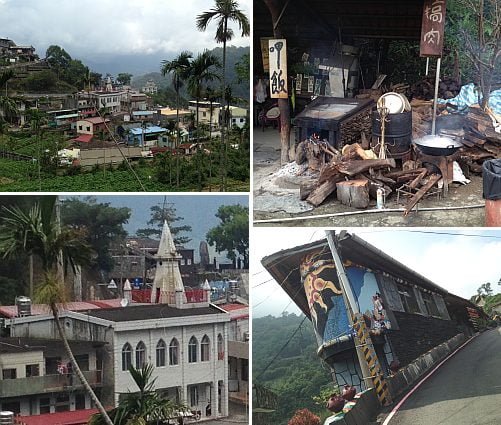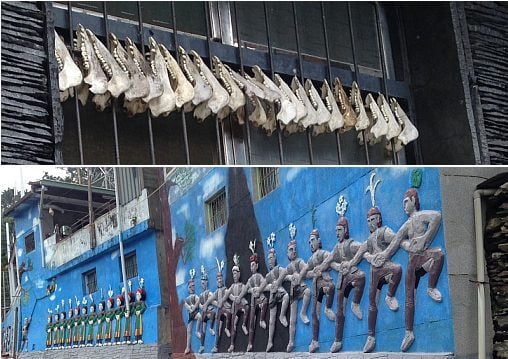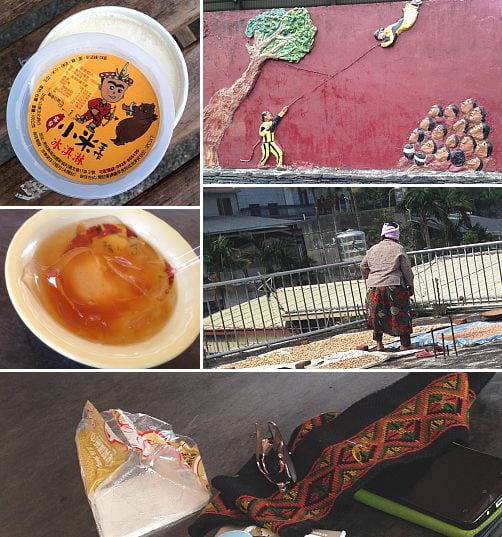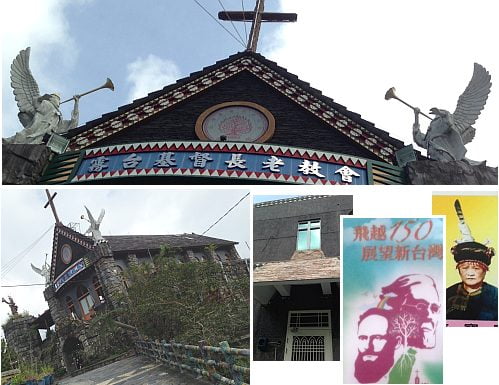With a few exceptions – like Australia’s and New Zealand’s – aboriginal peoples tend to be branded for tourist promotion purposes as local Red Indians. They must wear headbands with feathers, dance in circles, have totem poles and decorate things with stripes and zigzag patterns. So I was a bit skeptical when I found myself on a local bus going up into the hills of Pingtung County in southern Taiwan last week. Especially as we passed a sign welcoming the hordes to the Taiwan Indigenous Peoples Cultural Scenic Park Zone Hub and its gift shops full of headbands and totem poles.
However, even if the destination proved to be some sort of mock Disney thing with plastic thatched huts and staff in nylon loincloths, the ride was worth it. The mountain scenery is all hair-raising cliffs, soaring peaks, bends, swirling mists and waterfalls, and you can do it right now here. To add a touch of the dangerously wild and exotic, you have to fill in a registration form at a police checkpoint as you enter the Head-hunting Tribal Mountain Reservation (no-one checks names or ID, though)…
Eventually, you get to Wutai Township – a moderately picturesque settlement nestled on the side of a winding valley. It has some eccentric (think Steiner/eurythmy) rustic (mostly slate) architecture, which looks too modern in style to be authentic ‘savage jungle cannibal’, but at the same time looks completely non-lowland Taiwanese. You wonder if the roadside restaurant uses wood for fuel as a gimmick for tourists, or because it’s cheap (it doesn’t bother much with furniture, or overdo the hygiene, if that’s a clue). There’s also a grotty-looking church…
Rows of jawbones and more-naïve-than-native sculpted murals create a certain edgy ambiance…
It’s too grimy and gritty to be by Disney Imagineering. There’s obviously some sort of aboriginal heritage thing going on here, with some sort of government subsidy to give a theme-concept boost to what would otherwise be a pretty feeble local economy.
So who are these people? The place was pretty deserted (it presumably pulls in crowds at weekends). The inhabitants look distinctly Filipino, so my instinct was to think ‘gotcha!’ – they’ve imported migrant workers as actors. But actually, they are Rukai. They’ve been here a good 7,500 years longer than any Chinese, and now speak Mandarin as well as their own Austronesian (like Malay/Filipino) languages. And yes, they and their neighboring tribes were really into head-hunting, but not anymore (the jawbones are from wild boar).
The aboriginal culture lives on in the form of millet (as in millet ice-cream) and aiyu fig jelly. The elders dry peanuts and zip around the steep lanes on disability scooters. The woman who served up her home-made aiyu was also stitching a zigzag headband…
This is the authentic tribal heritage. By ‘authentic’, we mean no doubt oppressed and marginalized by Chinese settlers who turned up several centuries ago to plunder Formosa’s camphor. And – inevitably – we mean screwed up in the 19th Century by bearded bible-bashing Presbyterians. Been here before. Last time I was in Taiwan, I learnt about Dr Mackay, the Canadian missionary who pulled natives’ teeth for Jesus.
One noticeable thing about Wutai compared with plain everyday Taiwan is the complete absence of Buddhist, Taoist, kitchen-god, incense-burning, luck-bringing, ancestor-groveling Chinese religious features. Not one little roadside altar. The whole tribe was converted to Christianity – from shamanism and animism – in the 1860s, and they are still serious about it, complete with wacky Transylvanian-Mormon-style slate church…
The touristy things seem to meld into the ‘authentic’ 21st Century tribal culture fairly seamlessly. Serving fig jelly to trendy Kaohsiung-ites who are into indigenous ethnic culture is the culture, along with iPads, the peanut crop and going to church. If it comes to that, how much is Taiwan’s Chinese culture Americanized or Japanized, or how much is the Mainland’s contaminated by Manchu or Marx-Mao? Or Hong Kong’s by the evil imperialist mailboxes? Etc, etc.
Then, it’s back on the bus for the death-defying trip through the mountains down to the city…








A pleasurable trip through Taiwan. Thank you Hemmers.
Shades of Anthony Bourdain?
Welcome back, Hemmers.
I must say the way of life in the Formosan uplands knocks the spots off anything on offer here. I suppose we can thank the cretins in the Hong Kong tourism industry for that.
Many thanks for the account of your trip. Makes me want to jump on a plane to Kaohsiung pronto.
I got stranded on Lanyu (Orchid) Island, Tai Tung, during a typhoon.
Started to walk around the island and got picked up by one of the indigenous Yami islanders who took me to his home to meet his family. I spent a very interesting afternoon learning about life there.
They live in homes built in holes in the ground. The government tried to rehouse them in concrete homes over ground. Needless to say all the windows blew out due to strong winds.
Suggest you take a side trip there next time you go to Taiwan. Take some fruit over with you. Fishing was prohibited because of the nuclear fuel dump foisted on the residents. The land is very poor, only yams and taro appear to survive. The diet is therefore mostly packet noodles and tinned foods.
An eye opening experience.
I’ll be darned! Mountain passes still exist in Taiwan. In the late 1950s a 入山证 was the first requirement for a trek across or along the mountains of Central Taiwan and it was not easy to obtain. First we had to have an interview at the Taiwan Garrison Command followed by paperwork and another face-to-face at the Banqiao Regional Police Headquarters. One could not proceed beyond the foothills without producing a mountain pass permit at every police post along the way. At that time there was fear that the ‘Gongfei’ (Communist bandits) might try to create guerrilla bases in the Taiwan mountains, the way they had on the Mainland in Jiangsu and other provinces before 1949.
Once in the mountains there was not a Communist bandit to be spotted, only the occasional lowland Chinese traveling hawker selling cheap rot-gut alcohol subsidized by the KMT and a missionary or two. Strangely — at least to me — was the fact that the lingua franca in the mountains then was Japanese. One heard not a word of Mandarin, Hokkien or Hakka. When tribal people needed to communicate with outsiders, first out of the mouth was usually Japanese. This was at a time when it was against the law in Taipei to speak Japanese on the street . . . which I learned the hard way after a night in jail and a small fine.
There was one missionary I particularly remember in Tian Hsiang near the Taroko Gorge. Father Paul Coquoz was a Catholic missionary of the St. Bernard Order. He had fled northwestern Yunnan in 1951 where he and his predecessors had managed during a century of work to convert a couple of Tibetan villages to Catholicism and ultimately ended up in Taiwan. He built two large Swiss chalet lodges — or what appeared to be chalets — on his mission property. One was his residence and the other was for the tribal peoples among whom he worked in the slow task of spiritual conversion. But it turned out the tribal chalet was merely a facade. The front door opened to reveal the mouth of a dark cave in the hillside. Coquoz maintained that the aborigines felt uncomfortable in a bright room with a bed and running water, preferring instead to sleep on old tatamis he placed on the cave floor when they came down from the mountains on pastoral visits.
With another Double Ten just having passed, Clare Hollingworth at 104 looks more sprightly than the fast imploding KMT of the same age. People in Taiwan may soon be talking about ‘Guofei’ (Nationalist bandits) hiding in the hills.
If you follow Taiwan politics, then this blog may be of interest to you.
http://newbloommag.net/
I once spent a pleasant few days in the mountains of Taiwan at an aboriginal festival where the main idea was that the local tribe danced in circles for three days non-stop and got merrily off their faces on rice-wine (mijiu, not much like the stuff that is elsewhere called rice wine). Good times – A’Bian even came along to visit, this being in the days before his down-fall.
The reasoning behind it was something about dwarves stealling all their women and the dancing being to stop them coming back – or something like that, I was too drunk on mijiu to take it all in . . .